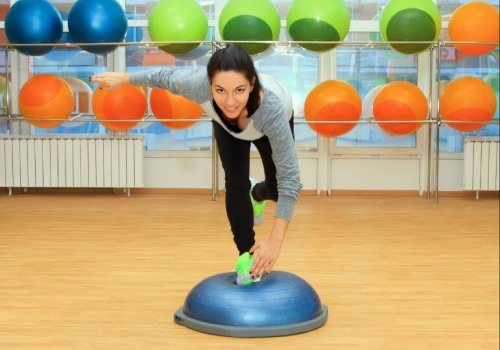Instability Training: What is it and What is it For?

In the search for greater muscular and nervous system activation, instability training is an ideal option nowadays. In the following article, we’ll explain the concept and usefulness of this type of training.
Instability training
In the last decade, instability training has become a widely popular method in sports centers, rehabilitation clinics, and gyms. It’s used to achieve all kinds of objectives; such as sports performance, better health, injury prevention, or sports rehabilitation.
When we mention unstable materials, we refer to those that we use to increase the demand for stabilization. They provide an unstable environment that will enhance proprioceptive activity and the demands of neuromuscular control.
Definition of stability
Stability is defined as “the ability of a body to maintain balance, to avoid being unbalanced”. We can also say it’s the ability of a structure to return to its position when a disturbing force is exerted on it.
Different authors (see bibliography) explain that, in order to have adequate stability, it’s necessary to have proper functioning in the following levels:
- Muscular: to regain a state of balance, we must have enough strength to do it.
- Neural: it’s not enough to have muscular structures that are able to generate certain levels of strength. We must also possess and manifest the ability to activate them at a certain intensity and at the right time.
With instability training, we are mainly working on a neural level. Despite this, to generate stability in the face of a movement that we’re executing in an unstable situation, we must first train our muscular component.
It’s important to know this aspect because even if we have a well-trained neural component to stabilize a movement, we’ll fail if we don’t have the appropriate structure to execute it. This case would entail excessive weight on the joints of the area being trained.

Balance
A definition of this concept is a generic term that describes the dynamics of body posture to prevent falls. We can also define it as a concept related to the forces acting on the body and the inertial characteristics of the body segments.
At the neural and physiological level, our balance depends on three aspects:
- Proprioceptive: the proprioceptive system gives us information about muscular, tendon, and joint structures.
- Vestibular: responds to body movements through space and changes in head position.
- Visual: refers to the system and the path that involves the provision of visual information.
Effects of instability training
There are many studies, such as the one by Behm, Drinkwater, Willardson, and Cowley, which show that training on unstable surfaces increases core muscle activation more than those we carry out under stable conditions.
This greater lumbar and abdominal activation is caused by the need to stabilize the spine and maintain postural control. Therefore, according to authors such as Grenier, at higher levels of spinal instability, we require:
- Greater activation of our core muscles.
- An increase in the activation ratio of agonist and antagonist muscles.
- More involvement of the antagonistic musculature.
- Greater need for joint stability.
- More joint stiffness.
- Less ability to produce strength and power.
Instability training offers a clear advantage. The authors cited that, although the instability reduces the production of force in this type of workout, the increase in contraction has a very important role for joint stability.
Instability training in rehabilitation and health
From a rehabilitation and health point of view, these types of materials seem to offer the possibility of reducing the incidence of low back pain. Additionally, they help increase the sensory efficiency of soft tissues that stabilize the ankle and knee. Therefore, this type of training allows us to:
- Restore normal functions of the stabilizing musculature.
- Maintain or improve core muscle function.
- Facilitate proprioceptive reeducation of injured lower limbs.
In regard to strength and power training, the increase in muscle coactivation produces a decrease in the production of strength that, in turn, enhances the stabilizing function of the muscles.

Instability in injury prevention
Regarding the effects of this type of training on injury prevention, scientific literature has been able to verify the effectiveness of the exercises performed on unstable surfaces.
Training the joints with potentially destabilizing forces may be a necessary stimulus for the development of effective compensatory neuromuscular patterns that can help prevent lower limb injuries.
For example, one of the conclusions we can draw from literature studies is that instability training reduces the total risk of suffering a lower limb injury by approximately 40 percent. This may be due to the enhancement in the proprioception of soft tissues or even to the improvement of balance.
Progression in instability training for the creation of unstable situations
Up next, we’ll show you an example of creating unstable situations. This work is based on the progression of tasks from a lower degree of difficulty to a higher one. This way, it will be easier to design training sessions.
- Support base (from highest to lowest).
- Movement speed, from isometric to dynamic.
- Associated motor patterns (oculopedic and oculomanual coordination).
- Disturbance of the regular balance system (visual system and position).
- Unstable surface: progression from a greater to a lesser degree of movement and level of instability.
- Supports: from highest to lowest number of supports.
- Greater muscular tension with external resistance.
- Use of displacements.
All these variables can be introduced in isolation or jointly, depending on the specific situations of the person undergoing the training. It’s important to individualize the work.
Comparing workouts: instability vs stability
After reviewing scientific studies and extracting information from relevant articles, we can draw some conclusions about whether to train on unstable surfaces or, on the contrary, do it on a stable surface:
- Some studies compared core muscle activation through unstable means or the same exercises without instability, but with heavy loads. After analyzing the results, they found that the greatest activation is achieved from a stable medium.

- In a 2010 study, Chulvi-Medrano, Garcia-Masso, Colado, Pablos de Morales, and Fuster compared the muscular activation of the paravertebral zone after performing conventional deadlifts on a stable surface and on an unstable one. After analyzing the records of electromyographic activity, the conclusion was that the best results, in terms of strength production and muscle activation, arise from the execution of this exercise on a stable surface.
- Most studies conclude that at higher levels of external instability, there’s less application of agonist force. Therefore, to improve strength performance, we need to have high levels of external stability.
- Regarding the muscular activation in the upper extremities, the studies explain that the muscular activation of the triceps and deltoids were greater when executing push-ups and chest presses on unstable conditions. However, they didn’t find a significant difference in the pectoralis major and the anterior rectus abdominis when performing these exercises on stable or unstable surfaces.
Conclusion
Not all studies have been able to demonstrate greater electromyographic and muscle activation records when performing exercises on an unstable base. Moreover, it’s important to know that muscle activation can be influenced by the use of an unstable surface. This circumstance is due to the fact that the muscles that participate in a movement don’t always get a higher degree of activation.
First of all, we must know what the true objective of our training is. This will enable us to choose whether it’s beneficial to use this medium as a complement and never exclusively. It’s necessary to investigate and analyze to find out if there’s a greater advantage or disadvantage when performing the exercises on a stable or unstable surface.
In the search for greater muscular and nervous system activation, instability training is an ideal option nowadays. In the following article, we’ll explain the concept and usefulness of this type of training.
Instability training
In the last decade, instability training has become a widely popular method in sports centers, rehabilitation clinics, and gyms. It’s used to achieve all kinds of objectives; such as sports performance, better health, injury prevention, or sports rehabilitation.
When we mention unstable materials, we refer to those that we use to increase the demand for stabilization. They provide an unstable environment that will enhance proprioceptive activity and the demands of neuromuscular control.
Definition of stability
Stability is defined as “the ability of a body to maintain balance, to avoid being unbalanced”. We can also say it’s the ability of a structure to return to its position when a disturbing force is exerted on it.
Different authors (see bibliography) explain that, in order to have adequate stability, it’s necessary to have proper functioning in the following levels:
- Muscular: to regain a state of balance, we must have enough strength to do it.
- Neural: it’s not enough to have muscular structures that are able to generate certain levels of strength. We must also possess and manifest the ability to activate them at a certain intensity and at the right time.
With instability training, we are mainly working on a neural level. Despite this, to generate stability in the face of a movement that we’re executing in an unstable situation, we must first train our muscular component.
It’s important to know this aspect because even if we have a well-trained neural component to stabilize a movement, we’ll fail if we don’t have the appropriate structure to execute it. This case would entail excessive weight on the joints of the area being trained.

Balance
A definition of this concept is a generic term that describes the dynamics of body posture to prevent falls. We can also define it as a concept related to the forces acting on the body and the inertial characteristics of the body segments.
At the neural and physiological level, our balance depends on three aspects:
- Proprioceptive: the proprioceptive system gives us information about muscular, tendon, and joint structures.
- Vestibular: responds to body movements through space and changes in head position.
- Visual: refers to the system and the path that involves the provision of visual information.
Effects of instability training
There are many studies, such as the one by Behm, Drinkwater, Willardson, and Cowley, which show that training on unstable surfaces increases core muscle activation more than those we carry out under stable conditions.
This greater lumbar and abdominal activation is caused by the need to stabilize the spine and maintain postural control. Therefore, according to authors such as Grenier, at higher levels of spinal instability, we require:
- Greater activation of our core muscles.
- An increase in the activation ratio of agonist and antagonist muscles.
- More involvement of the antagonistic musculature.
- Greater need for joint stability.
- More joint stiffness.
- Less ability to produce strength and power.
Instability training offers a clear advantage. The authors cited that, although the instability reduces the production of force in this type of workout, the increase in contraction has a very important role for joint stability.
Instability training in rehabilitation and health
From a rehabilitation and health point of view, these types of materials seem to offer the possibility of reducing the incidence of low back pain. Additionally, they help increase the sensory efficiency of soft tissues that stabilize the ankle and knee. Therefore, this type of training allows us to:
- Restore normal functions of the stabilizing musculature.
- Maintain or improve core muscle function.
- Facilitate proprioceptive reeducation of injured lower limbs.
In regard to strength and power training, the increase in muscle coactivation produces a decrease in the production of strength that, in turn, enhances the stabilizing function of the muscles.

Instability in injury prevention
Regarding the effects of this type of training on injury prevention, scientific literature has been able to verify the effectiveness of the exercises performed on unstable surfaces.
Training the joints with potentially destabilizing forces may be a necessary stimulus for the development of effective compensatory neuromuscular patterns that can help prevent lower limb injuries.
For example, one of the conclusions we can draw from literature studies is that instability training reduces the total risk of suffering a lower limb injury by approximately 40 percent. This may be due to the enhancement in the proprioception of soft tissues or even to the improvement of balance.
Progression in instability training for the creation of unstable situations
Up next, we’ll show you an example of creating unstable situations. This work is based on the progression of tasks from a lower degree of difficulty to a higher one. This way, it will be easier to design training sessions.
- Support base (from highest to lowest).
- Movement speed, from isometric to dynamic.
- Associated motor patterns (oculopedic and oculomanual coordination).
- Disturbance of the regular balance system (visual system and position).
- Unstable surface: progression from a greater to a lesser degree of movement and level of instability.
- Supports: from highest to lowest number of supports.
- Greater muscular tension with external resistance.
- Use of displacements.
All these variables can be introduced in isolation or jointly, depending on the specific situations of the person undergoing the training. It’s important to individualize the work.
Comparing workouts: instability vs stability
After reviewing scientific studies and extracting information from relevant articles, we can draw some conclusions about whether to train on unstable surfaces or, on the contrary, do it on a stable surface:
- Some studies compared core muscle activation through unstable means or the same exercises without instability, but with heavy loads. After analyzing the results, they found that the greatest activation is achieved from a stable medium.

- In a 2010 study, Chulvi-Medrano, Garcia-Masso, Colado, Pablos de Morales, and Fuster compared the muscular activation of the paravertebral zone after performing conventional deadlifts on a stable surface and on an unstable one. After analyzing the records of electromyographic activity, the conclusion was that the best results, in terms of strength production and muscle activation, arise from the execution of this exercise on a stable surface.
- Most studies conclude that at higher levels of external instability, there’s less application of agonist force. Therefore, to improve strength performance, we need to have high levels of external stability.
- Regarding the muscular activation in the upper extremities, the studies explain that the muscular activation of the triceps and deltoids were greater when executing push-ups and chest presses on unstable conditions. However, they didn’t find a significant difference in the pectoralis major and the anterior rectus abdominis when performing these exercises on stable or unstable surfaces.
Conclusion
Not all studies have been able to demonstrate greater electromyographic and muscle activation records when performing exercises on an unstable base. Moreover, it’s important to know that muscle activation can be influenced by the use of an unstable surface. This circumstance is due to the fact that the muscles that participate in a movement don’t always get a higher degree of activation.
First of all, we must know what the true objective of our training is. This will enable us to choose whether it’s beneficial to use this medium as a complement and never exclusively. It’s necessary to investigate and analyze to find out if there’s a greater advantage or disadvantage when performing the exercises on a stable or unstable surface.
All cited sources were thoroughly reviewed by our team to ensure their quality, reliability, currency, and validity. The bibliography of this article was considered reliable and of academic or scientific accuracy.
- Drinkwater, E. J., Pritche|, E. J., & Behm, D. G. (2007). Effect of instability and resistance on unintentional squat-lifting kinetics. Interna6onal Journal of Sports Physiology and Performance, 2(4), 400.
- Anderson, K., & Behm, D. G. (2005). Trunk muscle activity increases with unstable squat movements. Canadian Journal of Applied Physiology, 30(1), 33-45.
- Chulvi-Medrano, I., García-Massó, X., Colado, J. C., Pablos, C., de Moraes, J. A., & Fuster, M. A. (2010). Deadlift muscle force and activation under stable and unstable conditions. The Journal of Strength & Conditioning Research,24(10), 2723-2730.
- Behm, D. G., Drinkwater, E. J., Willardson, J. M., & Cowley, P. M. (2012). Declaración de Posición de la Sociedad Canadiense de Fisiología del Ejercicio: La Utilización de Inestabilidad para el Entrenamiento del Núcleo (CORE) en el Acondicionamiento de Poblaciones Deportivas y No Deportivas. PubliCE Standard.
- Behm, D.G.; Drinkwater, E.J.; Willardson, J.M.; Cowley. P (2010). The use of instability to train the core musculature review. Appl. Physiol. Nutr. Metab. Vol. 35
- Peña, G., Heredia, J., Moral, S., Mata, F., & Da Silva Grigoletto, M. (s.f.). Evidencias sobre los Efectos del Entrenamiento Inestable para la Salud y el Rendimiento . journal PubliCE Standard .
- Peña, G. (2014). Entrenamiento funcional y superficies inestables.
- Marin, P. J. (2010). Nuevas directrices del entrenamiento de fuerza en situaciones inestables.
This text is provided for informational purposes only and does not replace consultation with a professional. If in doubt, consult your specialist.








